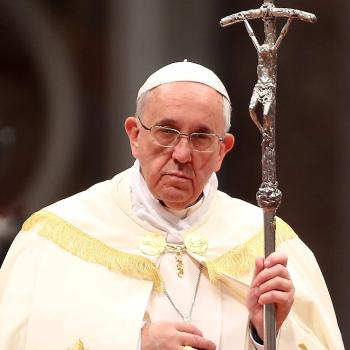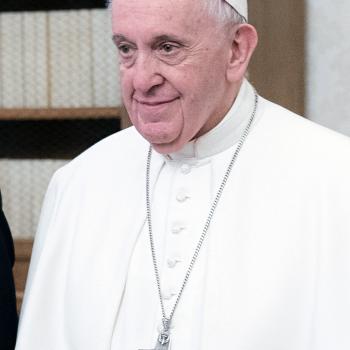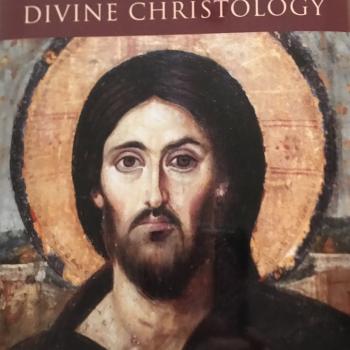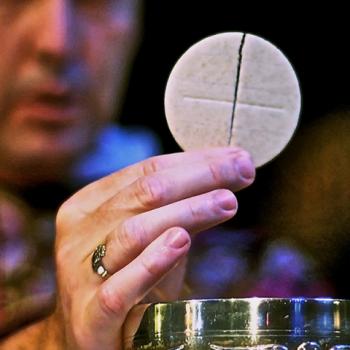A year ago one October Saturday, my wife and I were at Good Shepherd Catholic Church, in Alexandria, Virginia, which is a hop, skip and a couple turns from George Washington’s Mt. Vernon estate. It is a parish of the Arlington diocese.
We were there for our nephew’s Confirmation and I was his sponsor (poor kid). He had thought of asking his older brother—mostly, he said, because his off-to-college brother (jab, jab) hadn’t been to Mass in a while. But since this event was a family occasion, his brother wouldn’t have any excuse to avoid going. Well reasoned, I thought. So he settled on me. (He didn’t say it, not exactly, but I am his favorite his uncle.)
Being 1,200 miles away, I missed the orientation for sponsors. My brother-in-law walked me through it before Mass got underway. It wasn’t complicated, but there were twists to make, turns to take, and a special way of holding up the confirmand’s name card so the bishop might see who exactly he would be confirming and speak the name chosen for Confirmation.
So with my right hand on my nephew’s shoulder and my left hand holding a name card with a unobstructed view so the bishop could read it, I casually dismissed the temptation to tweak the boy’s ear or poke him inappropriately (I did that on the way back to the pew). Thus was he was anointed with the oil of chrism by the fourth bishop of the Diocese of Arlington, Michael F. Burbidge.
Bishop Burbidge stayed around for photos both morning and afternoon (there were two Confirmation Masses). One photo snapped with the confirmand, the bishop, and sponsor, and another with everyone else there for the confirmand. The bishop chatted briefly with everyone, posed, and shook hands with anyone who wanted to shake hands and never once betrayed the slightest fatigue. (If “how to do confirmation photos” isn’t covered by the Vatican School for New Bishops it ought to be, and Burbidge should teach it.)
In this way my nephew was “sealed with the gift of the Holy Spirit” and thereby strengthened for service in the Body of Christ, “signified and imprinted with a Holy Seal” as the Catechism of the Catholic Church [1293] explains it.
I am glad for my nephew. My part was ridiculously small. Living so distant, we did the stuff we were supposed to do together by phone. I had to answer questions about my own faith that he was told to ask, and anything else that came to mind. I presume, thereby, that in some small way I have aided his faith, as a sponsor is to do. If he has chosen wisely, he now has a model of faith, someone beyond his parents who in a non-parental context will to some degree act as a guide for his own maturing faith.
I am glad, too, for those other 120-some youth gathered for that Saturday, and for their sponsors. There were perhaps sixty kids and sponsors at the afternoon Mass. Roughly the same number were confirmed earlier mid-morning Mass.
But the fact is, unless Good Shepherd represents something way out of the norm, there are likely another 120 youth missing, unavailable for the bishops’ anointing. These would be the kids whose parents did not have the time or interest, or who were just too simply exhausted by the work week to haul them to the required minimum number of preparatory catechism sessions leading to Confirmation, or who had simply left the area.
I am not blaming the parents for the children’s absence—not entirely. They do bear a good deal of the burden, of course, but I’m not sure we can blame them even in large part.
The Church also bears much responsibility. Some of it rises from our own confusion about Confirmation itself. Figuring out exactly what Confirmation is for and what it does, and explaining it in deed and in practice, is some of that responsibility.
Instruction in the faith that leads to Confirmation at seventh grade too often feels like graduation from the practice of the faith.
Confirmation is sometimes criticized as a mere rite of passage, a reward for successfully completing a series of religion classes. It is much less anything doing with the Spirit and God’s grace since it must be “earned” by completing the required assignments. It appears to be much about books, projects, and questionnaires and not so much an encounter with the Holy Spirit.
One problem is answering how and to what degree Confirmation relates to Baptism.
If incorporation within the Body of Christ occurs at Baptism, does Confirmation offer something more to Baptism? Does it suggest that Baptism is incomplete until Confirmation, and only then are all the gifts of the Holy Spirit finally conveyed? Has something been withheld until now, when by Confirmation it is ultimately conferred in full?
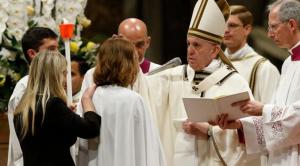
And then, let me throw in a ringer. What is the role of first communion? We slip it in after Baptism and before Confirmation. Coming in from a non-Catholic tradition, I could not commune until I was confirmed. An 8-year-old unconfirmed cradle Catholic gets to the Lord’s Table ahead of me? How does that happen? (No slight to 8-year-olds intended, expressly or otherwise.)
This, everyone admits, is a departure from the ancient sequence of Baptism, Confirmation, and first reception of Eucharist, all completed in one act. Eastern Catholics and the Eastern Orthodox still follow this pattern, an act called Chrismation. The reception of the Eucharist is not based on age or maturity, but upon their status as having been fully incorporated into the Body of Christ by virtue of being baptized. One sometimes hears “The young children ask for bread, But no one breaks it for them.” (Lam. 4:4)
To answer my question earlier, no, baptismal grace is exactly what it is, grace, nothing but grace—free grace. There are no books to read, papers to fill out or multiple choice quizzes to pass. There is only grace. There is no “half” grace that needs topping off around the seventh or eighth grade. It is grace, period.
But Confirmation is grace, as well. It confirms and is said to augment what baptism has begun. It is growth in holiness, that life-long yearning for the truth of Christ.
Yet both need to be distinguished in theology and especially in practice. If Baptism is our participation in the cross of Christ (Rm. 6), then Confirmation is our participation in the Pentecost of the Church (Acts 2). The first belongs as close as possible to the second. This is so we understand Confirmation as God’s gift to the Church and do not mistake it for an achievement, a graduation ceremony.
At least ten U.S. dioceses, as of 2011, have nudged Baptism and Confirmation into much closer proximity. The Diocese of Fargo has since 2003 conducted confirmation and first communion, together, at third grade. The Diocese of Saginaw began it in 1995. The Saginaw process is “Called to Continuing Conversion”. Confirmation follows baptism, first communion follows Confirmation. A vigorous youth program, the usual activities and learning, is ongoing.



